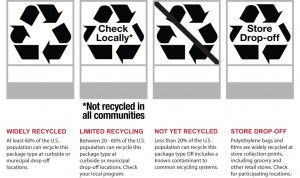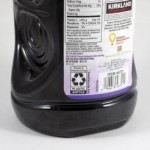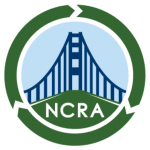 By Liz Bortolotto, NCRA News Contributor
By Liz Bortolotto, NCRA News Contributor
How2Recycle is a nationwide labeling standard for consumer products that identifies if the package is recyclable or not. With more than 37 companies on board – such as McDonalds, Coca-Cola, Kellogg and Proctor and Gamble, How2Recycle plans to become the standard for recycling labeling in the U.S. and Canada. A project of GreenBlue’s Sustainable Packaging Coalition, How2Recycle was developed to reduce consumer confusion around recycling with a clear and consistent recycling label. It provides companies with an easy way to conform to the Federal Trade Commission’s Green Guides. While several other recycling labels and symbols exist, the How2Recycle Label claims to be the only one that communicates recyclability across all material types and gives explicit directions to consumers to influence their recycling behavior. It also specifies when a package component is not recyclable.
 The label first appeared on packages in late 2011, including a variety of Kirkland products from Costco Wholesale, Clorox’s Scoop Away products, Minute Maid juice products, 95% of Seventh Generations’ products, Target’s private-label brands such as Up&Up, Market Pantry, Archer Farms and Simply Balanced and General Mills’ Green Giant, Betty Crocker, Chex, Yoplait and all of its cereals.
The label first appeared on packages in late 2011, including a variety of Kirkland products from Costco Wholesale, Clorox’s Scoop Away products, Minute Maid juice products, 95% of Seventh Generations’ products, Target’s private-label brands such as Up&Up, Market Pantry, Archer Farms and Simply Balanced and General Mills’ Green Giant, Betty Crocker, Chex, Yoplait and all of its cereals.
Companies are charged an annual fee of $2,000 to $6,000 for access to the How2Recycle label which includes support and periodic reviews. There is an additional set up fee. Locally, Alameda County’s StopWaste agency offers funding for companies headquartered or with significant operations in Alameda County to join How2Recycle up to $4,000 for the first year of membership. Sponsorships are also available for companies labeling polyethylene bags, wraps and other films.
While the label does provide nationwide consistency, there are vast differences in recycling collection among waste haulers nationwide. How2Recycle stresses that it is important for people to be familiar with what recycling is offered in their communities. There are numerous cases where a label might identify packaging as recyclable but that is not actually the case in a specific community. Conversely, there are numerous cases where a label identifies a package as not recyclable that actually is because only 20% of people nationwide are able to include it with their recycling. These situations should diminish as more of the U.S. population has access to full recycling collection.
